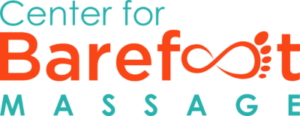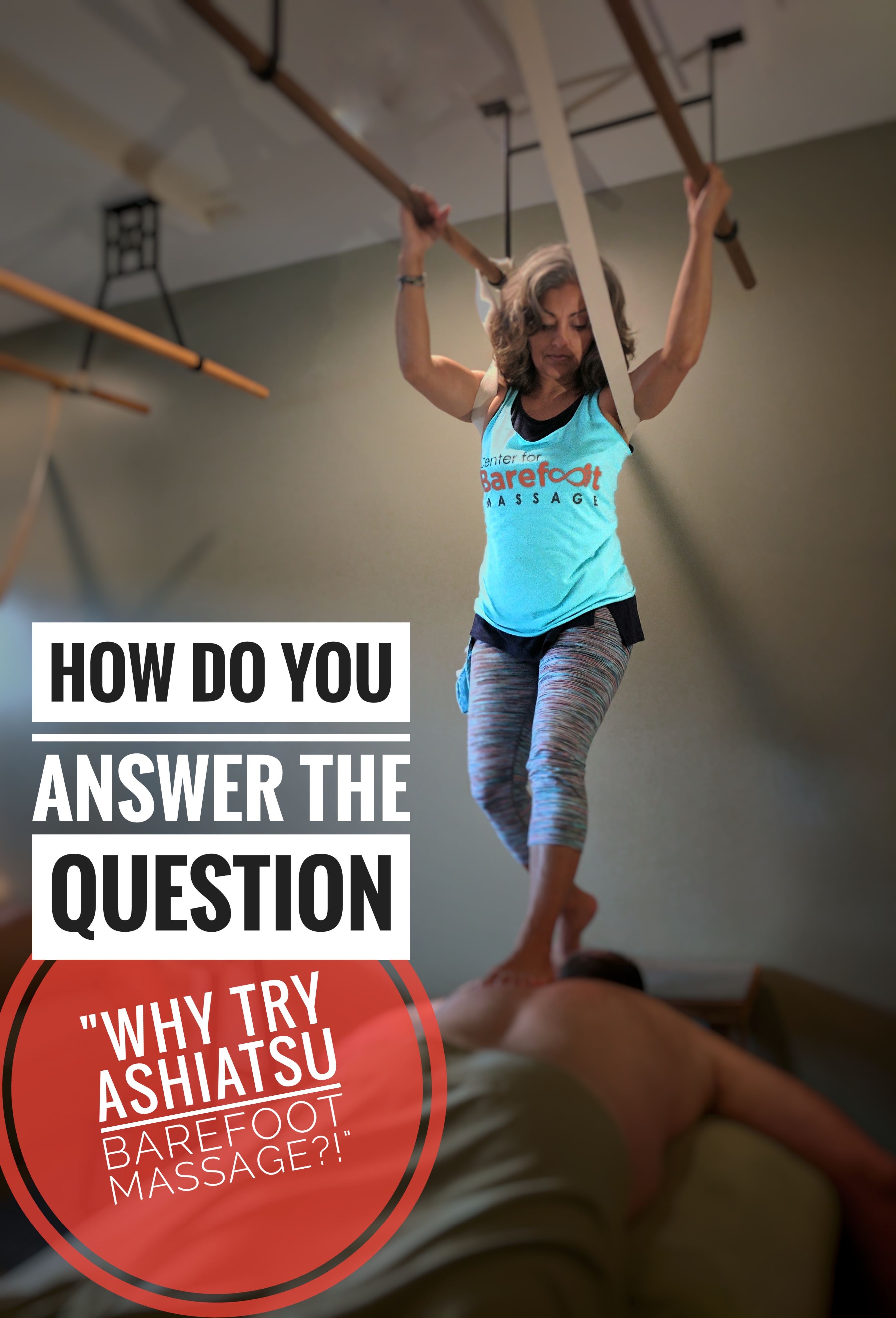Ashiatsu Barefoot Massage is a massage. That’s it, honestly. A licensed massage therapist will provide a professional, well educated massage service catered to a clients needs, and they just so happen to use their feet as the tools that deliver the technique, rather than hands. Why should a person try Ashiatsu?

You can talk about it’s depth and consistency of pressure. You can go on and on about how you use 1 foot at a time unless the client happens to weigh more than pounds than you… you can talk about your overhead bars or your super sturdy massage table… you can explain your soft, smooth, clean feet… you can mention how it saves your own body…. FOR REAL THOUGH!?
Do you go into that much detail when you explain a deep tissue massage that’s delivered from your upper limbs?! Not usually. Although ALL of this information is imperative to explain at some point during your client education, sometimes you are limited on time, so get to the point. Let them ask those questions instead, and you can come back to these key points while keeping them engaged in conversation.
How do YOU introduce this specialized technique to your clients or your surrounding community? Do you have a rehearsed elevator speech that explains the key benefits a person may experience when receiving an Ashiatsu massage from you? Sometimes an on-the-fly elevator speech seems intimidating, but it can be really fun and inspiring when you speak from your experience!
Instead of memorizing a script and repeating it back like a robot, aim to embody your own walking/talking advertisement so that when you need to, the words will roll off your tongue and fit the situation. Here are some tips to explain your work intuitively and fluently:
- Find your roots in your past training:
- Re-read all of your training manuals, and highlight key phrases that speak to you personally – only things that resonate with how you really feel about the massages you provide. Look at your FasciAshi class workbooks as well as every instruction reference material you’ve received from your continuing education courses – whether it be a cupping resource or an old trigger point protocol: inspiration can come from re-evaluating what you’ve already learned and diving deeper to a new level of understanding.
- Experience leads to results:
- Look at your client’s intake forms and take note of common tissue-issues they complain of… keep track of the 3 most common concerns, then look into your own SOAP or session notes and find commonalities in the treatment plans you typically create for those patterns. Look up massage research articles related to these issues and find how your sessions may relate to the style of work involved in those case studies. Explaining how you have helped people in the past, what is being discovered in the massage community, and what this potentially new client can expect from your experience will show much more credibility than a hypothetical story.
- Your vibe attracts your tribe:
- What do you see happening within the strokes that your feet perform? What are the words that describe what your massages feel like? Do you see a deep Swedish massage happening, or is it more like a Lomi Lomi flow? Is your approach more intense with a structural and myofascial intent, or are you dancing on your client, lulling them into a state of bliss?
You don’t have to say exactly the words your instructor said, and definitely don’t use another therapists service description: because you are not them! If you see Ashiatsu as the best Deep Tissue massage you can dish out, and if you can easily explain deep tissue in a way that gets their attention, then use that story. Just plug in the words “Ashiatsu Barefoot Massage” in place of the “deep tissue” phrase like a Mad-Lib. BOOM. Done. It can evolve from there.
- What do you see happening within the strokes that your feet perform? What are the words that describe what your massages feel like? Do you see a deep Swedish massage happening, or is it more like a Lomi Lomi flow? Is your approach more intense with a structural and myofascial intent, or are you dancing on your client, lulling them into a state of bliss?
Journal about these discoveries to help find your voice. If writing isn’t your thing, talk it out to yourself while on your next commute into work. Maybe even audio-record what you are saying so that you can listen to your flow and vocabulary.
Finding your voice, fine tuning the words, and getting to the point where you feel comfortable hearing yourself sell your own work, using your own style and personality will make talking to a stranger easier!
What we teach at the Center for Barefoot Massage isn’t cookie cutter massage, because YOU aren’t cookie cutter. We help you find the intent behind your strokes that is as deep as the work itself. If you need help finding your own voice within Ashiatsu to redefine your massage career, then check out our classes available across the nation: more dates are being added as our team grows.
What are some tips you have for creating an elevator speech? Let us know in the comments below!


I normally talk about who benefits from my massage more than the actual technique. I say that I “help people improve their lives by offering holistic solutions to ease stress, eliminate pain, and inspire self-care practices.”
I focus on the crowd that experiences depression, anxiety, burn-out, and related diseases. Ashi is great for this group and I think they appreciate the depth of a broad tool like the foot.
I thought I’d post a link to my Ashiatsu service description here from my website, http://www.heelingsole.com/massage-services/ashiatsu/
I’ve had this description for YEARS, it’s evolved overtime, but it’s been pretty similar all along. I’ve seen many LMT’s copy/paste it and use it for their own.
Don’t forget that GOOGLE ALWAYS KNOWS. It likes original content, and if it notices that you are using someone elses picture, or someone elses text, it will dock you in the rankings for that. So go ahead and use my service description…. but it’ll cost you a good ranking positing in the google searches.